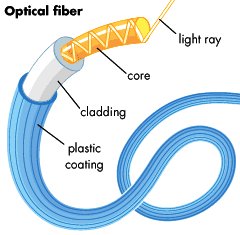New Technique for Monitoring of Power Transmission Cables
Why in News
Recently, researchers at IIT Madras have demonstrated that power transmission cable can be monitored by using Raman thermometry on the fibre optic cable.
- They achieved this by using the optical fibres that are already embedded in the power cables for establishing optical communication.
Key Points
- Raman Thermometry:
- It is a thermal characterization technique which makes use of Raman scattering phenomena to determine the local temperature in microelectronics systems.
- When light is scattered off an object, say a molecule, two bands are observed, with higher and lower frequency than the original light, called the Stokes and anti-Stokes bands, respectively.
- By studying the relative intensity of the two bands, it is possible to estimate the temperature of the object which scatters the light.
- The anti-Stokes component of Raman scattering is strongly dependent on the temperature that the material is subjected to. Thus, by measuring the intensity of the anti-Stokes scattered light we can estimate the temperature.
- Any current flowing through a conductor would cause a temperature rise due to the Joule heating effect. Hence the flow of current through the power cables results in heating of the power cables.
- Joule heating (also referred to as resistive or ohmic heating) describes the process where the energy of an electric current is converted into heat as it flows through a resistance.
- Optical Fibre Technique:
- The temperature measurement of wires is performed in not just one location, but in a distributed manner using an optical fibre. To achieve this, a pulse of light is launched into the optical fibre and the backscattered radiation is observed.
- Optical fibres are fabricated with high quality composite glass/quartz fibres.
- Each fibre consists of a core (denser) and cladding (rarer).
- When a signal in the form of light is directed at one end of the fibre at a suitable angle, it undergoes repeated total internal reflections along the length of the fibre and finally comes out at the other end.
- Total internal reflection is complete reflection of a ray of light within a medium such as water or glass from the surrounding surfaces back into the medium.
- Since light undergoes total internal reflection at each stage, there is no appreciable loss in the intensity of the light signal.

- Optical fibres are fabricated with high quality composite glass/quartz fibres.
- The time of flight of the backscattered radiation provides an estimate of the distance from which the light is backscattered.
- Backscattering (or backscatter) is the reflection of waves, particles, or signals back to the direction they came from.
- This constitutes a distributed measurement as the pulse propagates all along the length of fibre.
- This can go up to tens of kilometers.
- The temperature measurement of wires is performed in not just one location, but in a distributed manner using an optical fibre. To achieve this, a pulse of light is launched into the optical fibre and the backscattered radiation is observed.
- Significance:
- Actual Temperature Measurements:
- The use of Raman thermometry technique allows the operators to get the results for actual temperature measurements over tens of kilometres.
- Economic and Real-Time:
- Alternative methods of measuring the temperature of power cables include using a thermal camera which is cumbersome. The present method devised by the team is both economical and provides real-time information.
- Thermal cameras detect temperature by recognizing and capturing different levels of infrared light.
- Alternative methods of measuring the temperature of power cables include using a thermal camera which is cumbersome. The present method devised by the team is both economical and provides real-time information.
- Actual Temperature Measurements:
Raman Effect
- The Raman Effect or Raman Scattering is a phenomenon in spectroscopy discovered by the eminent physicist Sir Chandrasekhara Venkata Raman in 1928.
- In 1930, he got a Nobel Prize for this remarkable discovery and this was the first Nobel Prize for India in the field of Science.
- The Raman Effect is a change in the wavelength of light that occurs when a light beam is deflected by molecules. When a beam of light traverses a dust-free, transparent sample of a chemical compound, a small fraction of the light emerges in directions other than that of the incident (incoming) beam.
- Most of this scattered light is of unchanged wavelength. A small part, however, has wavelengths different from that of the incident light; its presence is a result of the Raman Effect.